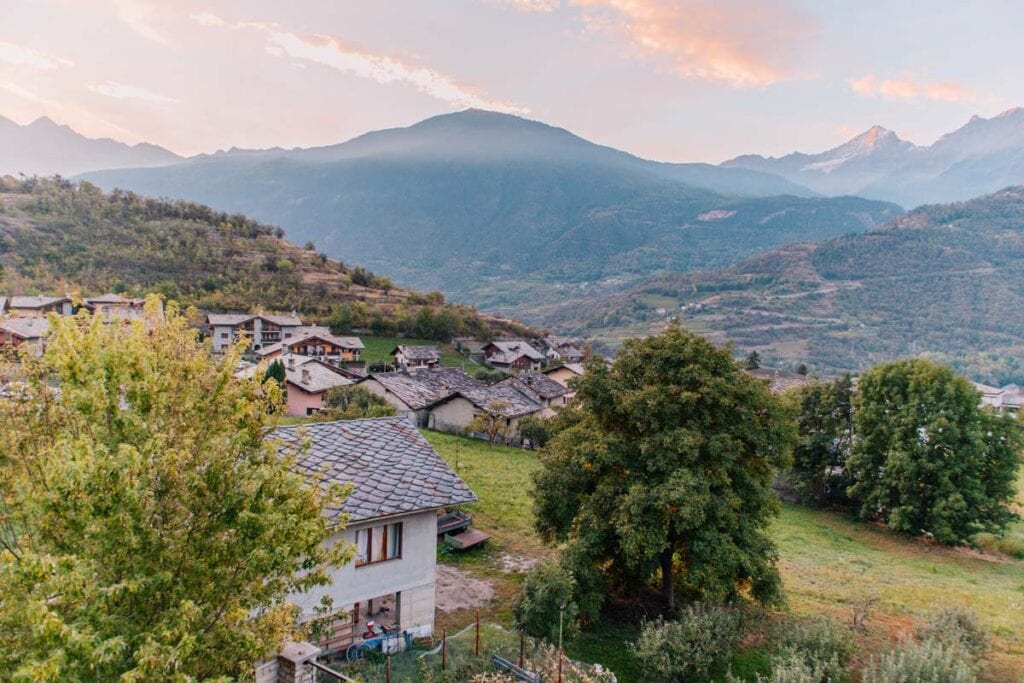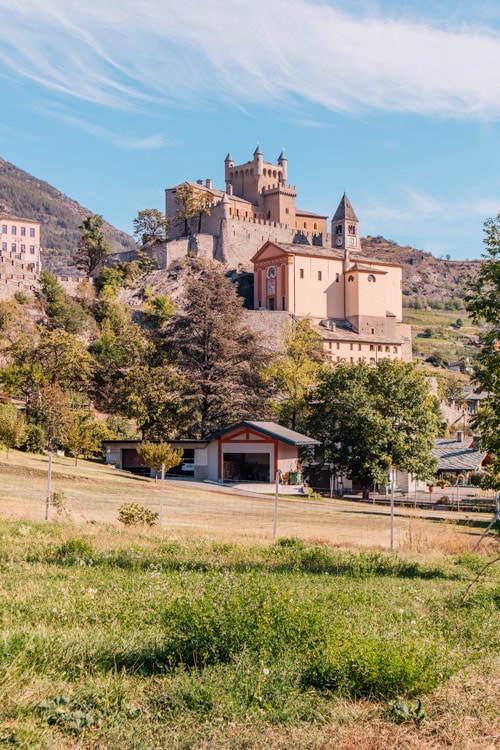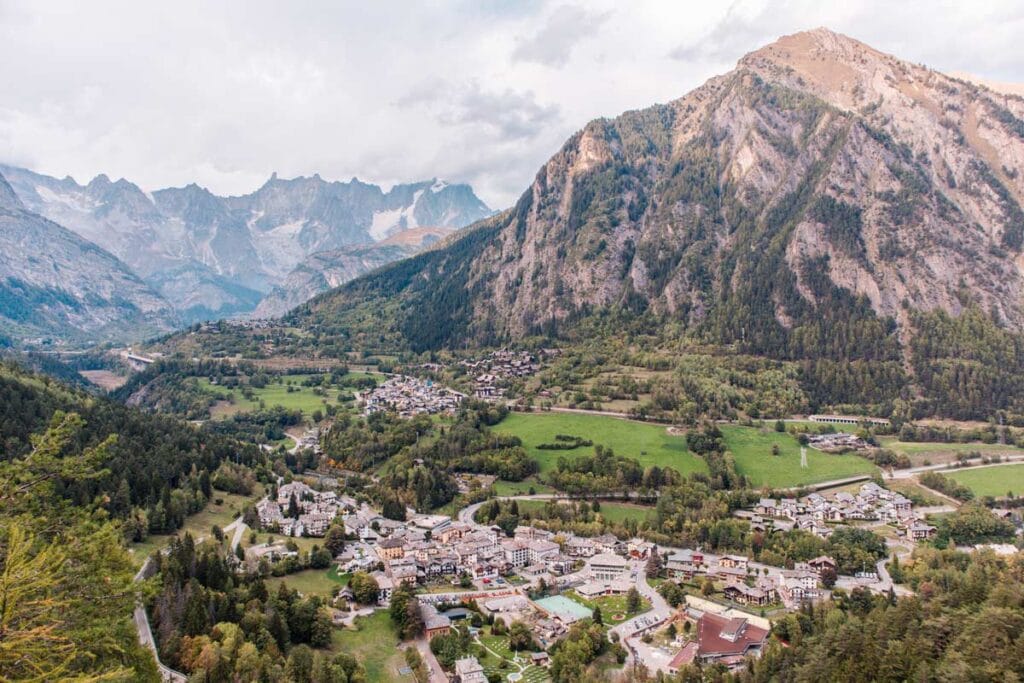Is Aosta worth visiting? Whether you’re referring to the region of Aosta Valley (Valle d’Aosta) as a whole or just its capital city, I’m here to share everything I liked and disliked about them.
I can already tell you that this was one of my favorite trips ever, but we all have different travel preferences, so here’s what you need to know before booking your flight.
*This post may contain affiliate links from which I earn a commission (for more info, read my disclosure). As an Amazon Associate, I earn from qualifying purchases. This post may show pop-ups.
*I try to keep the information on this blog as updated as possible, but I still recommend consulting the latest prices, opening hours, and other details on the official website of each site, hotel, and tour, as well as checking the updated public transport routes and timetables.

My favorite carb in Aosta Valley: Despite the abundance of savory delicacies, I cannot forget the adorable little desserts and pastries of Pasticceria Buzzi, located on the main road near Nus.
A Few Facts About Aosta Valley
- It’s Italy’s smallest and least populated region.
- French has been spoken in the area for centuries, and today, it is an official language in the region.
- One of its most famous legends says that the ancient Roman bridge of Pont-Saint-Martin was actually built by the devil.
Is Aosta Worth Visiting? All the Reasons to Love the Aosta Valley Region
You Can Enjoy the Dreamiest Natural Landscapes With or Without Hiking
Nature is definitely Aosta Valley’s most prominent attribute and the thing it’s most famous for, and I couldn’t get enough of it.
It’s pretty impossible not to gush over the clusters of mountains that seem like they’re hiding behind one another and fading into the horizon, the hidden waterfalls, and the mesmerizing color of the Dora Baltea River and the region’s lakes.
A huge bonus is that you can take all that beauty in whether you’re a super hiker, a beginner, or not interested in hiking at all because these landscapes are all around you once you set foot in Aosta Valley.

When road-tripping the region, the most stunning mountainous scenery is just outside the window.
I also got to majestic spots like Brusson Lake, Cascade of Lenteney, and the Skyway Monte Bianco Cable Car, which offers jaw-dropping views over the Italian side of the Mont Blanc and its surroundings.
If exploring Aosta Valley on foot is more up your alley, more than 5000 km of trails are available.
A short hike is all you need to marvel at places like the Lillaz Waterfalls in the infamous Gran Paradiso National Park, a true paradise for nature lovers, and you’ll find dozens of routes for more experienced hikers, not only in this park but all across the region.




Lots of Opportunities for Other Outdoor Activities
Beyond hiking, Aosta Valley allows you to engage in plenty of other exciting activities, from rafting, canyoning, and kayaking to cycling, rock climbing, and winter sports.
Beautiful Castles and Fortresses
Dotting the valley, you’ll come across countless gorgeous castles and fortresses built between the 11th and 19th centuries for either local noble families or the House of Savoy.
The dynasty’s main seat was the region of Piedmont, but it also ruled the area of Aosta under the Duchy of Savoy, the Kingdom of Sardinia, and the unified Kingdom of Italy.
I was thrilled to marvel at the impressive Fort of Bard (built for the Savoy family and now functioning as a museum and a hotel – Hotel Cavour) as well as the picture-perfect Saint-Pierre Castle, Fenis Castle, Aymavilles Castle, and a few others.
Just seeing their exteriors made me happy, though most also offer guided tours (some only in Italian).
That said, I wish I wouldn’t miss the Issogne Castle, the Sarre Castle, and the fairytale-like Castel Savoia.


Quaint Towns
One of my favorite things about Aosta Valley is the charm of the adorable Alpine towns and villages that complement the natural scenery so well.
Their wooden and stone houses with balconies adorned with colorful flowers are exactly what I want my home to look like someday.
Not every house in every town has this kind of appearance, but there’s more than enough of them to win you over, especially in places like Avise and Courmayeur.

Thermal Baths
Did you know that this region is home to natural thermal springs? That’s right!
They were inaugurated in the 19th century in Pré Saint Didier at the foot of the Mont Blanc (though they were already known in Roman times) and discovered in Saint-Vincent in the 18th century.
I’m dreaming of going back to Aosta Valley for a northern Italian wintertime trip with relaxing spa days amidst the snowy landscapes, but you can visit these towns’ spa and wellness centers and resorts year-round:
- QC Terme Monte Bianco wellness center and resort
- QC Terme Pré Saint Didier wellness center
- Terme di Saint-Vincent wellness center

Hearty Food and Amazing Wines
Northern Italian dishes are my ideal comfort food, as many of them are heavy, hearty, and filling, exactly what you’d want to eat when the weather gets cold.
If there’s one ingredient that shines in Valdostan cuisine (Valdostan = of Valle d’Aosta), it’s fontina cheese. It originates in the region and has been produced here for centuries, so it’s no wonder it has a Protected Designation of Origin (PDO).
You’ll find it in many scrumptious regional dishes, such as Risotto alla Valdostana, Fonduta alla Valdostana (fondue), and Polenta concia (it was so yummy), so if you love carbs and cheese as much as I do, you’re in for a treat.
Surprisingly, Aosta Valley is also an undiscovered destination for wine lovers, with beautiful vineyards and quite a few wineries dotting the region (I loved Les Cretes in Aymavilles, established in 1800).
Grape varieties here include Picotendro (Nebbiolo), Prié blanc, Chardonnay, and Pinot Noir, to name a few, and some of the recommended wines to try are Blanc de Morgex et de La Salle, Nus Rouge, and Nus Malvoisie.
If you love discovering regional Italian food and wines, you won’t be disappointed.

It’s a Wonderful Road Trip Destination
I’ve come to love car-free trips, and technically, you can travel to several points of interest in Aosta Valley by bus (like the Skyway Monte Bianco Cable Car and the city of Aosta), but I believe this region is best explored by a good old Italian road trip.
It will allow you to reach exciting nooks and crannies that public transportation just doesn’t, including lakes, castles, viewpoints, and towns from where you can take hikes for all levels.
So, if you’re a road trip addict who loves the flexibility and freedom to stop wherever and whenever you feel like it, this destination is for you (here’s my detailed itinerary).

You Can Visit in Every Season
It’s difficult to pick the best time to visit Italy because each season has so much to offer.
With its ski areas and resorts, such as Courmayeur Mont Blanc Funivie, La Thuile, and Breuil-Cervinia Valtournenche Zermatt, Aosta Valley is an incredibly popular Italian winter destination.
But its natural scenery and northern Italian climate also make it a delight to explore in other seasons. Possible rainy days should always be taken into consideration, but the local average temperatures from mid-spring to mid-fall are pretty ideal.
I visited in October and thought it was going to rain non-stop, but I got to enjoy perfect weather – sunny days with a light cold breeze in the mornings and evenings, so I would gladly travel there again in late spring and summer.

Small Things That Bothered Me About Traveling in the Aosta Valley
*While you need to know these things, they are certainly not deal breakers in my eyes.
The Main Road Is Not Well-Lit
Two main roads pass through the region, the SS26 and the E25 highway, connecting to many small roads that allow you to reach more remote places.
You’d expect them to be well-lit after the sun sets, but some areas don’t have street lights at all, so drive extra carefully.
Some Businesses Are Closed in the Shoulder Seasons
Summer and winter are the peak seasons in the Aosta Valley, and in between, it’s important to know that some hotels, restaurants, and shops are closed.
Visiting northern Italy in October, I didn’t mind the no-crowds aspect (I’m an introvert and an HSP, so that’s right up my alley), but the Valdostan nature allowed me to enjoy more than enough tranquility, so I did want a bit of liveliness in the towns I visited.
With quite a few businesses closed (which I get), some towns felt completely deserted and not as fun to wander around, not to mention that it was a bit challenging to find a place to eat a few times. The biggest exception here is the city of Aosta.

Restaurants Are Only Open on Certain Hours
Another thing to know (and again, I get it), which you should consider when planning your daily itinerary, is that many restaurants are usually only open from 12 PM to 2 PM and from 7 or 8 PM to 10 PM.
Some are also closed for one day throughout the week, though usually not on Sundays.
Is Aosta Worth Visiting? Things to Love About Aosta City
Lovely Roman Landmarks
Apart from the castles and fortresses I’ve mentioned, you’ll also find Roman ruins and landmarks scattered throughout the region – mainly bridges and even one aqueduct you can actually walk through in Pont d’Aël (it’s not big, but I did like the uniqueness of the experience).
But the most impressive ones are in the city of Aosta, the capital of the region and the former Roman colony of Augusta Praetoria. That’s why it’s also known as the Rome of the Alps.
Beyond the awe-inspiring Roman theatre (currently closed until May 2025), perhaps the city’s most emblematic symbol, you can see the city gate Porta Praetoria, the triumphal Arch of Augustus, the ancient wall remains, and the Roman bridge.
These, along with Aosta’s medieval sites, will surely satisfy your sightseeing needs.

Charming Historic Center
Some of these landmarks stand in the heart of Aosta’s historic center, which I enjoyed roaming freely. Lined with shops, restaurants, cafes, and bars, its streets and squares are pretty charming.

Things to Dislike About Aosta City
Other Areas Are Underwhelming
I never expect every little corner to be picture-perfect, but Aosta Valley is so scenic that I really couldn’t ignore the unappealing appearance of the areas outside the historic center, especially because this is the biggest city in the region, yet the old town is quite small.
Some residential neighborhoods look okay, but there’s nothing to do there as travelers, and overall, Aosta’s gloomy and unattractive industrial and commercial areas seem like too much of a contrast to the historic center and everything else you see in this beautiful region.
Traffic and Parking
Being the biggest city in the region, it’s not surprising that getting in and out of Aosta by car takes time because of the traffic. Also, you can find public parking lots, but spots aren’t always available.
These can be issues if you choose to base yourself in Aosta while road-tripping the valley, so the least you can do is be aware and book accommodation with private parking. Here are some other options for places to stay in Aosta Valley.

The Verdict
Is the region of Aosta worth visiting: Aosta Valley is absolutely worth adding to the bucket list! Everything about it has won me over, from the views to the landmarks to the food, and I just know you’re going to love it too, whether it’s your first or 20th time in Italy.
Is the town of Aosta worth visiting: While I can’t say it was the highlight of my trip, I still think it’s a nice place to visit as a stop on a road trip or even a day trip from Turin.
If you have any questions, ask them in the comments below!
Other Italy Travel Guides
More about Italy:
- Hidden gems in northern Italy
- Places to visit in Lombardy, northern Italy
- Things to do in Vicenza, northern Italy
- Italian lakes road trip
- Best road trips from Milan
- Piazzas in Italy
- Gifts for Italy lovers
- Italy travel quotes
- Romantic novels set in Italy
- Central Italy bucket list
Related posts:
- Reasons to visit Turin
- Reasons to visit Warsaw
- Reasons to visit Budapest
- Reasons to visit Cadiz
- Reasons to visit Poznan
- Reasons to visit Madrid
- Reasons to visit Kefalonia
- Is Cordoba worth visiting
- Is Porto worth visiting
- Is Crete worth visiting
- Is northern Spain worth visiting
- Is Mallorca worth visiting
- Is Bari worth visiting
- Is Malta worth visiting


Hi, I am contemplating an idea to invest in a holiday apartment in Valle d’Aosta, just for the family, not for any short-term rent. I wonder if it is a good idea, considering that prices are really cheap (at least in the valley). The area of Chatillon/Saint-Vincent seems probably the best considering distances to all five major ski resorts (Cervinia, Pila, Monterosa, La Thuile and Courmayeur). Obviously, I am aware that those are tiny, quiet towns with not many attractions, but actually it is even better. I am not into clubbing or pub crawling. The main factor and the mountains for skiing and hiking and also relative proximity of big cities, or for short weekend breaks, possibility of trips to the lakes in Lombardia, the seaside in Liguria and even further skiing in France in their gorgeous resorts such as Tignes, 3 Vallees, Les Arcs, La Plagne or Chamonix. The whole thing looks really attractive, so I only wonder why the prices of properties are so low. They are comparable to Calabria or Sicilia! Is there anything I am not aware of? Pollution, lack of sunshine in the valley, lot of rain, nasty people, floods, aliens landing??? Just joking, I don’t presume so. I take into account that the region is depopulating and that, generally, Italy is cheaper than the other countries, when one looks at other mountaneous regions (e.g. Val di Sole, Livigno, Dolomiti, Val di Fiemme, Kronplatz) it is completely different range of prices, also a bit away from the slopes. Is the region a hidden gem yet to be discovered?
Hey!
I’m in no way an expert on the holiday home and real estate market in Italy, and I did not spend enough time in the region to have an opinion on it as someone who lives their everyday-life there. But I can say that it is quite a hidden gem. It definitely has all the advanatges you mentioned in terms of location, and I personally fell in love with it, especially because of its tranquility and nature.